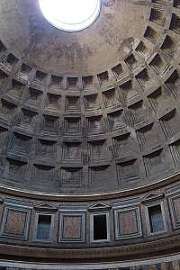
Concrete is a wonderfully versatile material, which has been in use since Roman times and with it we can build amazing structures that would otherwise be impossible. Unfortunately it also carries a huge environmental cost, caused mostly in the cement binding used. Whilst gravel extraction is also an issue, for that there are some alternatives such as recycled, crushed concrete.
The production of modern cement (OPC – ordinary portland cement) is a hugely polluting process and produces around 8% of the world’s carbon emissions – at least twice that of the aviation industry. Whilst the Romans used a volcanic dust called pozzolona as their binding agent, until the invention of OPC, we used lime, in various forms. Lime too has to be processed by heat and so is not without it’s environmental cost, but it uses less energy to produce than cement and lime concrete/mortar reabsorbs carbon over its lifetime (if exposed to the air), offsetting some of the initial pollution. Moreover, because it is softer, materials can be disassembled easily, for re-use.

In a landscape, there is ubiquitous use of concrete in a range of structures – walls, paving, sub-bases, ponds etc. some of which could be reduced or avoided altogether. Whilst landscaping will always use an insignificant amount of concrete compared to urban development and infrastructure, there are good reasons to minimise the volume of cement and other hard landscape materials used.
Some of these reasons are for obviously sustainable goals: reducing material/resource input and carbon and other wastes. Equally important in my view, is to increase the soft elements exposed in a garden – soils – and to increase the levels of planting and foliage biomass/diversity. This thinking is about the increase of biophilic benefits.
However, if sustainability is to be given top priority – as it must – then the use of cement has to be reduced as much as possible. This is quite a challenge to us all, as it is not always easy to find an alternative and I don’t suggest for one minute that it should never be used, but it should be reserved for essential structural use only. Even then there may be alternatives. Recycled concrete can make a suitable aggregate (or part of) and low cement alternatives such as CEM 1 reduce the energy and carbon emissions tally.
I have used – and continue to use – concrete in many of my own designs and so this challenge is personal – but then aren’t all sustainability issues.
Let’s look at the different areas of the garden where cement is used:

Walling
Many walls use cement, either in mortar or in concrete blocks as well as in cement renders. In this garden (left) we built retaining walls using hollow concrete block construction on concrete footings with cement render and mineral pigments for the final colouring, with concrete paving slabs as coping. As the site was on a chalk hillside, it may have been possible to construct this using rammed chalk or earth. Indeed, we had a surplus of chalk on the site from the house construction and it would have made perfect eco-sense to have used this to build the walls. The walls could have been rendered using lime based mix, and the coping could have been stone. As the chalk hillside is inherently quite stable, rammed chalk could possibly have been used for the footings too. However, there are so many unknowns, and so few UK examples that it is a risk to do this, especially on such structurally critical terracing. Long-term effects of damp creeping into the walls would have been my main concern.
The cost of rammed earth construction may have been cheaper than conventional construction , both in time to do and in material purchase, especially when the removal off site of subsoil is taken into account.
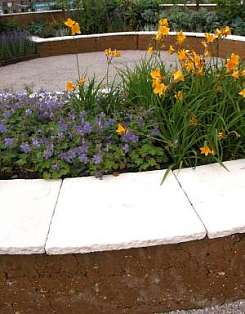
Rammed earth garden walling and Cement-substitute coping, GDL.
The picture at right shows rammed earth walls in a sustainable landscape I designed for Grand Designs Live, ExCel, 2006. Rammed earth walls are made by compacting subsoil inside timber or metal formwork. The soil must be kept dry so it needs some kind of footing and capping, here provided by cast copings made with recycled aggregates and partial cement substitute (CEM 2 furnace slag). The gravel to the main paving area is a recycled brick/concrete mix, laid through a geo-grid membrane made from recycled plastic. The aim here is to be as carbon neutral as possible. Planting aspired to be edible (you can eat daylily flowers).
Walling alternatives to concrete include:
- Cement alternatives/recycled aggregates
- Rammed Earth
- Timber walling (railway sleepers etc)
- Round pole walling (preferably coppiced hardwood)
- Fences & crib-type embankment walls
- Brick/stone with lime mortar (brick also has high energy input)
- Dry Stone walling
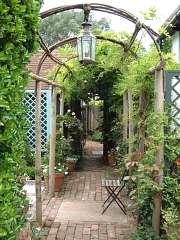
Paving
Modern paving is often made from concrete and in some instances it is quite hard to find realistic substitutes. Stone paving is the obvious one but can be expensive. There are many cheaper stone imports available these days, such as Indian Sandstone, which are cost-effective but which carry a high transport and pollution price tag. Reclaimed York paving is highly desirable and of course, reused, so environment friendly but will cost 2-3 times that of cast concrete or Indian Sandstone. Brick is also traditional as paviors but as for walling, still carries a high energy/pollution cost in production, plus is expensive to lay.
For larger areas and drives, self-binding gravels may be one of the better answers, as these form a firm surface, once compacted, without the use of cement. Recycled or local gravels are also acceptable and can be held in place using recycled plastic grids/membranes.
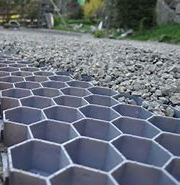
Paving is one of those areas which highlights the question of just what is sustainable. Is it better to use imported sandstone with its high transport miles but relatively low energy production, or locally made concrete paving with cement and aggregate use, but low transport miles? In either case, the (financial) costs may be similar. There are also ethical and human welfare considerations for stone imported from third world countries, especially in terms of working conditions, health & safety and child labour.
Timber decking can be a viable alternative, especially on sites with changes of levels. Local timbers of the more durable softwoods (like Douglas fir or larch), green oak, Sweet chestnut or recycled tropical hardwoods. All new timbers should be FSC (Forest Stewardship Council) certified. New hardwoods should be avoided even if the have an FSC certificate as there is much illegal timber that still gets sold and even managed plantations may still involves some environmental degradation. They certainly have high transport emissions.
Possible paving alternatives:
- Recycled stone, brick, cobbles – and concrete slabs
- Self binding aggregates don’t need cement
- Fired paviors and tile look beautiful, but are still energy intensive
- local or recycled aggregates and gravels
- Decking can be used where appropriate
- Locally produced concrete slabs minimise transport and can have lower carbon footprint than imported stone
- Third-world stone may be low energy, but high transport emissions
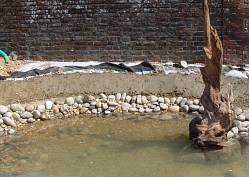
A “natural” pond marginal shelf with protective concrete pad
Ponds
Even natural looking ponds may use concrete in their construction and formal ponds may be dominated by it. Again choice of alternatives is limited.
Concrete is often used to retain rocks and place protective pads over liners, etc. In many places it may be possible to do without concrete pads, which are often used in a “belt-and-braces” approach to protecting a liner. Felt geomembranes are used as standard as a layer underneath and often inside the liner (this may in fact be degraded by contact with concrete) and in many cases, use of additional layers of felt may eliminate the need for concrete. Felt is usually a synthetic, petroleum based product, so also has its environmental considerations (as do liners!). I have successfully used old carpet as replacement for felt, under the pond (I wouldn’t recommend it inside) but be VERY wary of tacks that may have been used. Non-synthetic carpet will degrade over time, which must be born in mind. Of course, before the advent of felt, liners were simply bedded on a layer of sand.
Where rocks and stones create waterfalls, they are used to form spillways and to prevent stones moving when climbed over or stepped upon (an important safety consideration). It may be possible to use hydraulic lime based concretes for this, although I haven’t tried this out. Perhaps well laid rocks, without the use of cement are the key, which would require a careful re-thinking of the construction method. Nature doesn’t use concrete, but then natural streams don’t retain water within an artificial environment (liner). A more holistic approach to water features, where the roof water and household grey water are recycled and the pond design doesn’t hold a fixed level or amount of water, may be the long term answer.
So looking at alternatives to cement raise as many questions as answers and in the 12 or so years since this article was first written, there has been some progress, but not much. Best advice is to minimise the use wherever possible, recognising the long-term durability and benefits of strength that concrete possesses.
First published in 2007, updated 2019

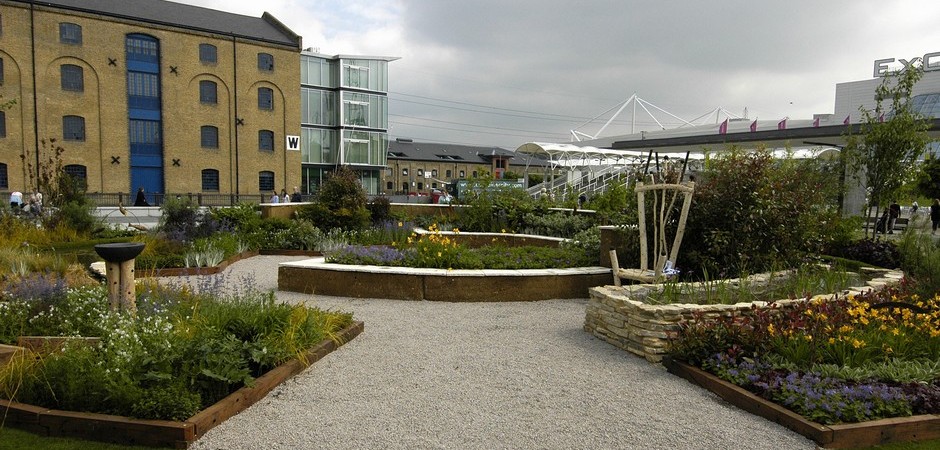
Hi
We have a partly concreted area that was once a bomb shelter and now houses an old shed. This is at the back of our garden with a large area to we need to do something with. I would rather not concrete the whole area but it does need clearing and levelling – total space 6meter wide by 5 meters deep. Any greener ideas would be helpful.
Hi, difficult to tell without seeing it, you could consider cleaning back the area and covering with gravel? Any addition sub-base areas can just be compacted sub-base, the standard is MOT type one, or scalpings. You may be able to get crushed concrete, which would have a lower carbon footprint (if local). Any gravel surface may need some kind of retaining edge to constrain the aggregate, if you don’t want gravel that is too loose, consider using a geogrid (from recycled plastic) to hold it in place.
The carbon footprint of alternatives composed of recycled materials, such as ferrock, ashcrete, timber crate, and hempcrete, is typically lower than that of concrete. These materials also aid in the recycling of waste products like steel dust and chaff.
in my homeland, the people use mud to make walls. We make big fortes in the villages with almost all mud and wood made.
Good article! A wealth of information on concrete and alternative materials makes it a valuable resource for anyone interested in sustainable landscaping and construction. With in-depth analysis and practical insights, it offers guidance for eco-conscious individuals seeking innovative project solutions.
One area that stood out to me is the use of concrete in garden structures, where alternatives like timber, recycled stone, or even self-binding gravels can be highly effective. As someone passionate about sustainable landscaping, this has made me rethink how concrete is being used unnecessarily in many outdoor projects. It’s a challenging balance between structural integrity and environmental responsibility, but by making small changes in how we approach design, we can still achieve lasting results without heavily relying on cement.